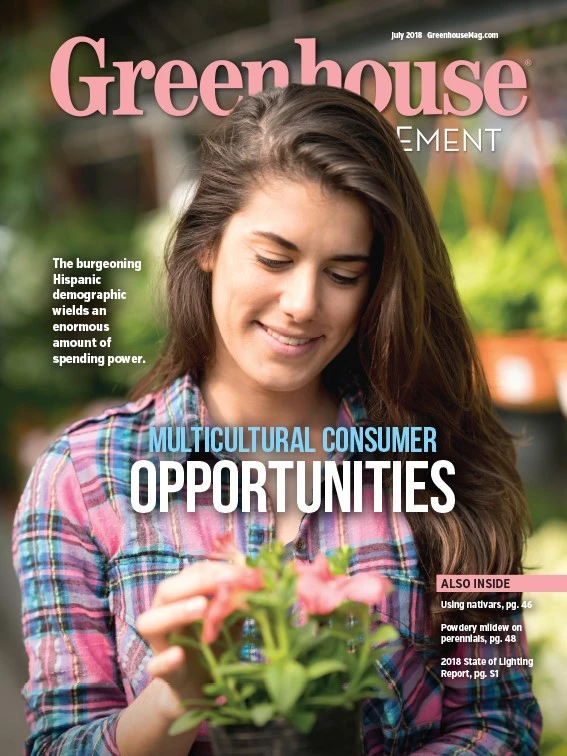
There is clearly an increased interest in ecological plants in the horticulture industry. Whether it is for landscaping for sustainable certification, improving environments for pollinators and wildlife, or for phytoremediation or restoration, plants that contribute to green infrastructure and ecosystem services are becoming more important in our industry. Under this broad category of plants are native plants. Now, in no way, shape, or form am I going to try and answer the question “What is native?” in this article. I don’t have a definitive answer myself, and it is a subjective topic that opens up a broad and nuanced conversation. However, there is clearly an interest in native plant materials. For the majority of garden and landscaping purposes, nativars are great plants that should be commercially grown for retail sales to general consumers.
Nativar is the combination of “native” and “cultivar.” Nativars are plants that were selected from native plant species because they have some sort of outstanding ornamental appeal and landscape performance and are good horticultural cultivars. Nativars are great plants to use in landscapes to provide ornamental appeal as well as ecosystem services. Take, for example, ‘Blue Heaven’ little bluestem (Schizachyrium scoparium). When a collection of little bluestem seedlings was grown out for evaluation, this plant was selected because, while most little bluestem grasses tend to flop or lie down at the end of the growing season, ‘Blue Heaven’ maintained an upright form to provide more structural interest in the landscape. Or ‘Blue Moon’ woodland phlox (Phlox divaricata) selected for profuse flowering or ‘Bluebird’ smooth aster (Aster laevis) selected for its robust growth. Compared to the wild species, these relatively straightforward and simple selections are improvements in appearance and performance, but the selection can still provide ecosystem services.
Some are concerned that by using nativars, we are reducing genetic diversity. That concern is well-founded, because a nativar — or any cultivar — is a single genotype.
However, in promoting using nativars in landscapes, I am not suggesting any sort of ecological restoration of landscapes, like trying to reconstruct a prairie or woodland. Clearly wild genetics should be used in those instances. I am suggesting nativars to be used in residential and commercial landscapes in urban, periurban and suburban landscapes, as well as those rural landscapes that are not immediately joined to wild spaces. By using nativars, these residential and commercial areas benefit from the ornamental and aesthetic appeal consumers want in gardens and landscape designs, while still benefitting the environment. Furthermore, these are the markets that you are most likely already producing more traditional annuals and perennials for. Nativars can complement this product mix.

Research is supporting the idea that, for nativars that were selected as simply “improved” forms of the wild species, they can provide the benefits of their wild counterpart. Researchers at the University of Vermont conducted a study that compared the appeal of straight native species and nativars of herbaceous perennials to insects and pollinators. In several instances, they found that there were no differences between the straight native genetics and nativars that were simple selections of improved forms of species. However, they did find that pollinator visits to nativars declined compared to wild genetics when the nativar was the result of crossing two different species, not just selecting an improved form of a single species.
In addition to avoiding nativars that are crosses between different species, there are some other qualities in nativars that should be avoided when trying to maintain their ability to support wildlife. In some cases, though the ornamental interest may improve when selecting nativars, ecosystem services for wildlife can decrease. Douglas Tallamy discussed a few traits of ornamental plants that can diminish ecosystem services in his book, “Bringing Nature Home.” First, insects tend to feed less on foliage that is variegated or an entirely different color (i.e. purple) than the wild species, and nativar selections should benefit wildlife like insects. Additionally, plants that were selected for their double flowers should be avoided. When a flower is a double, there are no reproductive organs like pistils or stamens, where pollen and nectar may be found by pollinators, nor will seeds be formed for other wildlife to eat.
Consider the benefits of diversifying your ornamental product line by producing nativars. Nativars selected for simple trait improvements that improve horticultural appeal such as improved form, enhanced branching or prolific flowering can be great garden plants and contribute to the health of our landscapes. When selecting nativars to produce, take into consideration how any horticultural improvements in the cultivar may affect the plant’s ability to support wildlife. With a little discrimination, you can ensure that the nativars you select and produce are going to make our landscapes more beautiful and functional.

Explore the July 2018 Issue
Check out more from this issue and find your next story to read.
Latest from Greenhouse Management
- Anthura acquires Bromelia assets from Corn. Bak in Netherlands
- Top 10 stories for National Poinsettia Day
- Langendoen Mechanical hosts open house to showcase new greenhouse build
- Conor Foy joins EHR's national sales team
- Pantone announces its 2026 Color of the Year
- Syngenta granted federal registration for Trefinti nematicide/fungicide in ornamental market
- A legacy of influence
- HILA 2025 video highlights: John Gaydos of Proven Winners





